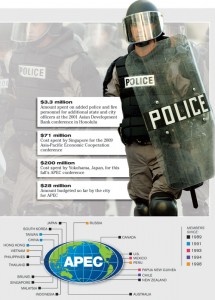The recent APEC summit in Honolulu brought an unprecedented level of security which locked down entire parts of the city. For the first time since the martial law years of World War II, we saw military patrolling and securing areas of Waikiki.
The police also loaded up on military style weapons, which raised concerns about the militarization of the police.
Although the police did not use any of their new toys against the peaceful protests that occurred, they are now armed to the teeth for future contingencies, such as…it’s not clear. The recent police attacks on the Occupy movement across the U.S. has raised concerns about the militarization of police in the U.S.
Marine Corps veteran Scott Olsen was seriously injured when a tear gas canister struck him in the head.
In the New York Times, Al Baker asks what it means When the Police Go Military:
RIOT police officers tear-gassing protesters at the Occupy movement in Oakland. The surprising nighttime invasion of Zuccotti Park in Lower Manhattan, carried out with D-Day-like secrecy by officers deploying klieg lights and a military-style sound machine. And campus police officers in helmets and face shields dousing demonstrators at the University of California, Davis with pepper spray.
Is this the militarization of the American police?
[…]
The more the police fail to defuse confrontations but instead help create them — be it with their equipment, tactics or demeanor — the more ties with community members are burned, he said. The effect is a loss of civility, and an erosion of constitutional rights, rather than a building of good will.
“What is most worrisome to us is that the line that has traditionally separated the military from civilian policing is fading away,” Mr. Lynch said. “We see it as one of the most disturbing trends in the criminal justice area — the militarization of police tactics.”
Of course for many poor communities and communities of color, this kind of violent, oppressive militarized police presence is nothing new. Former Los Angeles police chief Daryl Gates was infamous for his extreme brutality in his war against the poor communities of Los Angeles. At one point he even offered President Carter a LAPD SWAT unit to liberate hostages in Tehran.
But another disturbing bit of news is a little known program called the “1033 Program” under which the military gives surplus weapons to local law enforcement. In Battlefield Main Street, Benjamin Carlson reports in The Daily, this program is turning Main Street into a battlefield:
In today’s Mayberry, Andy Griffith and Barney Fife could be using grenade launchers and a tank to keep the peace. A rapidly expanding Pentagon program that distributes used military equipment to local police departments — many of them small-town forces — puts battlefield-grade weaponry in the hands of cops at an unprecedented rate.
Through its little-known “1033 program,” the Department of Defense gave away nearly $500 million worth of leftover military gear to law enforcement in fiscal year 2011 — a new record for the program and a dramatic rise over past years’ totals, including the $212 million in equipment distributed in 2010.
The surplus equipment includes grenade launchers, helicopters, military robots, M-16 assault rifles and armored vehicles.
And the program’s recent expansion shows no sign of slackening: Orders in fiscal year 2012 are up 400 percent over the same period in 2011, according to data provided to The Daily by the Pentagon’s Defense Logistics Agency.
Passed by Congress in 1997, the 1033 program was created to provide law-enforcement agencies with tools to fight drugs and terrorism. Since then, more than 17,000 agencies have taken in $2.6 billion worth of equipment for nearly free, paying only the cost of delivery.
Experts say the recent surge is simply the continuation of a decades-long trend: the increasing use of military techniques and equipment by local police departments, tactics seen most recently in the crackdowns on Occupy Wall Street protesters across the country. But critics of the program say that the recent expansion of 1033 distributions should be setting off alarm bells.





One Reply to “The Militarization of Police”